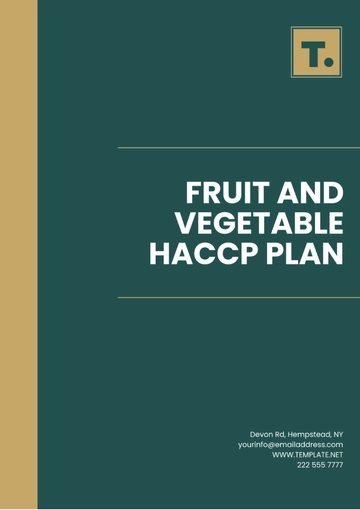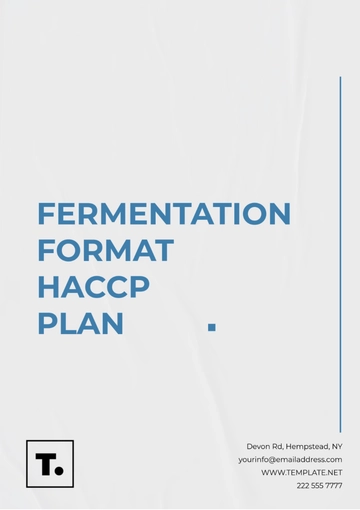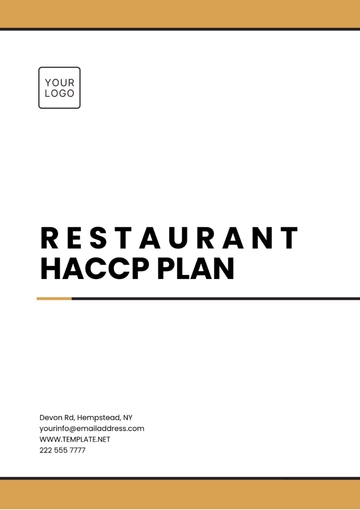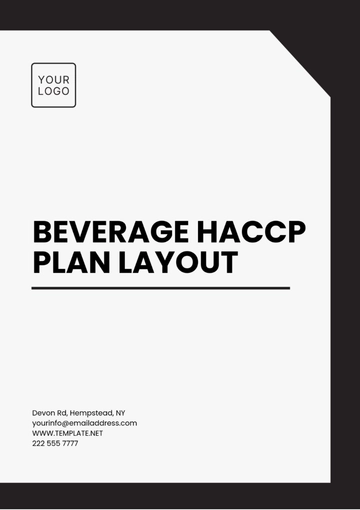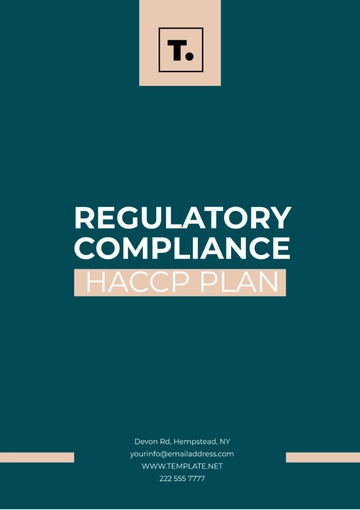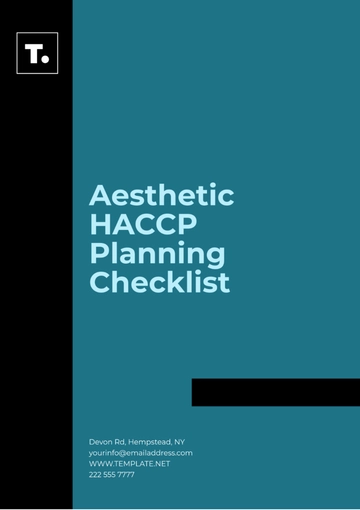Free Restaurant HACCP Plan

Date: February 20, 2060
Prepared by: [YOUR NAME]
I. Introduction
The purpose of this Hazard Analysis and Critical Control Point (HACCP) plan is to ensure the highest standards of food safety in our restaurant. By systematically analyzing each stage of food processes, we aim to identify potential hazards and implement effective measures to prevent foodborne illnesses. This plan not only supports compliance with food safety regulations but also fosters a culture of safety and quality in our operations, ensuring the well-being of our customers and staff.
II. Scope
This HACCP plan encompasses all stages of food preparation and handling within our restaurant, including:
Receiving: Inspection and acceptance of raw ingredients.
Storage: Proper storage conditions for all food products.
Preparation: Safe handling and preparation practices.
Cooking: Procedures to ensure thorough cooking.
Cooling: Rapid cooling techniques to minimize bacterial growth.
Reheating: Ensuring foods are reheated to safe temperatures before serving.
Serving: Maintaining food safety during service to customers.
III. HACCP Team
Our HACCP team consists of individuals with diverse expertise to effectively implement and maintain food safety standards:
Mason Harris - Head Chef: Responsible for overseeing food preparation and ensuring compliance with cooking procedures.
Isaac Shaw - Quality Assurance Manager: Ensures that all food safety protocols are met and quality standards are maintained.
Eli Hayes - Kitchen Supervisor: Monitors daily kitchen operations and enforces food safety practices among staff.
Jackson Hayes - Restaurant Manager: Provides overall management and support for the HACCP plan implementation.
Lucas Nelson - Food Safety Consultant: Offers expert guidance and conducts regular training sessions for staff.
IV. Hazard Analysis
Through comprehensive analysis, we have identified potential hazards associated with food handling and preparation, categorized as follows:
Biological Hazards: Includes bacteria (e.g., Salmonella, E. coli), viruses (e.g., Norovirus, Hepatitis A), and parasites (e.g., Giardia).
Chemical Hazards: Involves potential contamination from cleaning agents, food additives, and pesticides.
Physical Hazards: Includes foreign objects such as glass, metal shards, plastic, or wood that may inadvertently enter food products.
V. Critical Control Points (CCPs)
We have established the following Critical Control Points (CCPs) to manage identified hazards:
Receiving: Monitor and control the temperature of raw ingredients upon delivery to ensure they are within safe ranges.
Cooking: Implement procedures to verify that food is cooked to the appropriate internal temperatures, effectively eliminating pathogens.
Cooling: Utilize rapid cooling methods (e.g., ice baths, and blast chillers) to bring down the temperature of cooked foods swiftly to prevent bacterial growth.
Reheating: Ensure that foods are reheated to a minimum internal temperature of 165°F (74°C) before serving to guarantee safety.
VI. Monitoring Procedures
Temperature Checks: Regular temperature readings using calibrated thermometers at critical stages (receiving, cooking, cooling, and reheating).
Visual Inspections: Routine visual checks and audits to confirm compliance with food safety protocols and proper hygiene practices.
Microbial Testing: Conduct microbial testing as necessary to verify food safety, especially in high-risk areas.
VII. Corrective Actions
If monitoring shows a departure from set limits at any CCP, the corresponding corrective actions will be taken.
Temperature Adjustments: To ensure that the food items meet safety standards, it is important to either cook them again or modify the temperature at which they are cooked.
Food Discarding: Safely discard any food that is deemed unsafe to eat due to being exposed to incorrect temperatures or contamination.
Procedure Revision: Review and revise procedures as needed, followed by retraining staff on updated protocols to prevent future occurrences.
VIII. Verification Procedures
Verification procedures are critical to ensuring the ongoing effectiveness of our HACCP system. These will include:
Record Reviews: Regular audits of monitoring records and documentation to ensure compliance and identify areas for improvement.
Internal Audits: Conducting comprehensive internal audits quarterly to assess adherence to HACCP protocols.
Annual Reviews: A thorough annual review of the HACCP plan, with updates made as necessary to reflect changes in processes, regulations, or new hazards.
IX. Record Keeping
Comprehensive documentation is crucial for proving compliance and verifying the effectiveness of our HACCP plan, so we will keep the following records:
Temperature Logs: Detailed logs of temperature checks at CCPs, including dates, times, and results.
Corrective Action Reports: Records of any corrective actions taken in response to monitoring deviations.
Audit and Inspection Results: Documentation of internal and external audit findings and any subsequent actions.
Training Records: Comprehensive records of all staff training sessions, including attendance and training topics covered.
- 100% Customizable, free editor
- Access 1 Million+ Templates, photo’s & graphics
- Download or share as a template
- Click and replace photos, graphics, text, backgrounds
- Resize, crop, AI write & more
- Access advanced editor
Ensure food safety compliance in your restaurant with the Restaurant HACCP Plan Template from Template.net. This editable and customizable template guides you through setting up a comprehensive HACCP plan, covering food preparation to serving. Editable in our Ai Editor Tool, it allows you to tailor the plan to your restaurant's specific operations.
You may also like
- Finance Plan
- Construction Plan
- Sales Plan
- Development Plan
- Career Plan
- Budget Plan
- HR Plan
- Education Plan
- Transition Plan
- Work Plan
- Training Plan
- Communication Plan
- Operation Plan
- Health And Safety Plan
- Strategy Plan
- Professional Development Plan
- Advertising Plan
- Risk Management Plan
- Restaurant Plan
- School Plan
- Nursing Home Patient Care Plan
- Nursing Care Plan
- Plan Event
- Startup Plan
- Social Media Plan
- Staffing Plan
- Annual Plan
- Content Plan
- Payment Plan
- Implementation Plan
- Hotel Plan
- Workout Plan
- Accounting Plan
- Campaign Plan
- Essay Plan
- 30 60 90 Day Plan
- Research Plan
- Recruitment Plan
- 90 Day Plan
- Quarterly Plan
- Emergency Plan
- 5 Year Plan
- Gym Plan
- Personal Plan
- IT and Software Plan
- Treatment Plan
- Real Estate Plan
- Law Firm Plan
- Healthcare Plan
- Improvement Plan
- Media Plan
- 5 Year Business Plan
- Learning Plan
- Marketing Campaign Plan
- Travel Agency Plan
- Cleaning Services Plan
- Interior Design Plan
- Performance Plan
- PR Plan
- Birth Plan
- Life Plan
- SEO Plan
- Disaster Recovery Plan
- Continuity Plan
- Launch Plan
- Legal Plan
- Behavior Plan
- Performance Improvement Plan
- Salon Plan
- Security Plan
- Security Management Plan
- Employee Development Plan
- Quality Plan
- Service Improvement Plan
- Growth Plan
- Incident Response Plan
- Basketball Plan
- Emergency Action Plan
- Product Launch Plan
- Spa Plan
- Employee Training Plan
- Data Analysis Plan
- Employee Action Plan
- Territory Plan
- Audit Plan
- Classroom Plan
- Activity Plan
- Parenting Plan
- Care Plan
- Project Execution Plan
- Exercise Plan
- Internship Plan
- Software Development Plan
- Continuous Improvement Plan
- Leave Plan
- 90 Day Sales Plan
- Advertising Agency Plan
- Employee Transition Plan
- Smart Action Plan
- Workplace Safety Plan
- Behavior Change Plan
- Contingency Plan
- Continuity of Operations Plan
- Health Plan
- Quality Control Plan
- Self Plan
- Sports Development Plan
- Change Management Plan
- Ecommerce Plan
- Personal Financial Plan
- Process Improvement Plan
- 30-60-90 Day Sales Plan
- Crisis Management Plan
- Engagement Plan
- Execution Plan
- Pandemic Plan
- Quality Assurance Plan
- Service Continuity Plan
- Agile Project Plan
- Fundraising Plan
- Job Transition Plan
- Asset Maintenance Plan
- Maintenance Plan
- Software Test Plan
- Staff Training and Development Plan
- 3 Year Plan
- Brand Activation Plan
- Release Plan
- Resource Plan
- Risk Mitigation Plan
- Teacher Plan
- 30 60 90 Day Plan for New Manager
- Food Safety Plan
- Food Truck Plan
- Hiring Plan
- Quality Management Plan
- Wellness Plan
- Behavior Intervention Plan
- Bonus Plan
- Investment Plan
- Maternity Leave Plan
- Pandemic Response Plan
- Succession Planning
- Coaching Plan
- Configuration Management Plan
- Remote Work Plan
- Self Care Plan
- Teaching Plan
- 100-Day Plan
- HACCP Plan
- Student Plan
- Sustainability Plan
- 30 60 90 Day Plan for Interview
- Access Plan
- Site Specific Safety Plan







